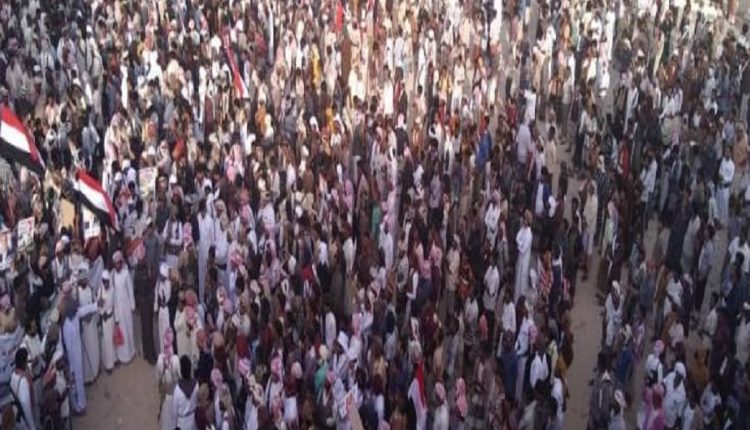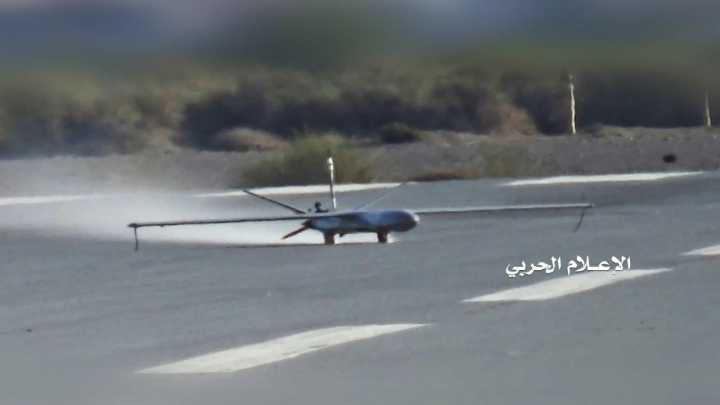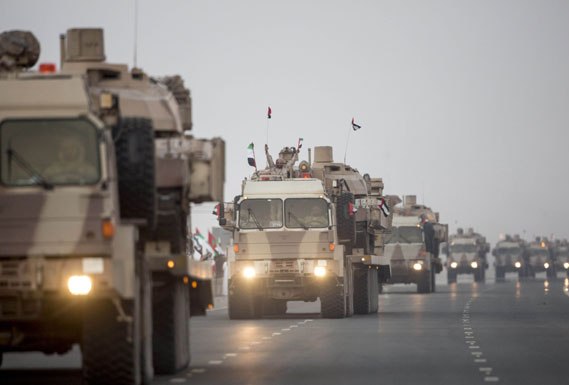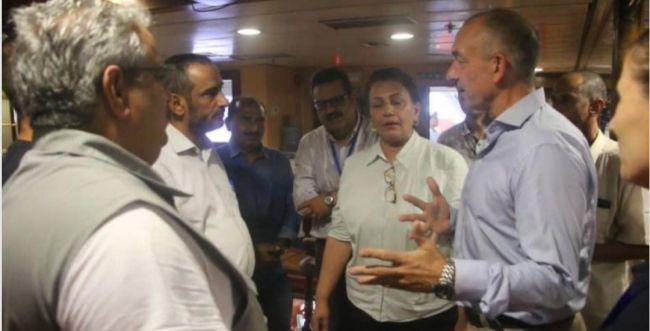www.aljazeerah.info
News, July 2019
Archives
Mission & Name
Conflict Terminology
Editorials
Gaza Holocaust
Gulf War
Isdood
Islam
News
News Photos
Opinion Editorials
US Foreign Policy (Dr. El-Najjar's Articles)
www.aljazeerah.info
|
Editorial Note: The following news reports are summaries from original sources. They may also include corrections of Arabic names and political terminology. Comments are in parentheses. |
UAE Starts Withdrawal from Yemen, Talks to Resume on Hudayida Ship to Implement Swedish Agreement
July 14, 2019
 |
 |
| Yemenis-protest-against-the-Saudi-led-coalition-backed-by-the-US-in-2019 | Yemeni drone, Samad 1, file, July 14, 2019 |
 |
 |
| UAE troops withdrawing gradually from Yemen, file, July 14, 2019 | UN Observer, Lolisgaard, met the Yemeni government representatives on the re-deployment committee on board a ship off the coast of Hodeidah, July 14, 2019 |
***
The following news stories are from the Yemeni independent website Al-Masdar ( http://www.almasdaronline.com/category/42 ):
***
Lolisgaard meets the government team in re-deployment committee on board a ship off Hodeidah
July 14, 2019, ALMASDARONLINE ١٤ íæáíæ ٢٠١٩
The head of the UN observer mission, Lt. Gen. Lolisgaard, met the government representatives on the re-deployment committee on board a ship off the coast of Hodeidah in preparation for the resumption of meetings to discuss the implementation of Hodeida-related section of the Swedish agreement.
According to media sources, the government team headed by Major General Saghir bin Aziz arrived on Saturday evening, while the Houthi representatives are scheduled to arrive in the coming hours to a United Nations ship anchored at sea to hold meetings on board after the dispute over the venue of the meeting and the rejection of each party Access to the other party's place of control for the meeting.
The arrangements for the meeting come amid mounting shelling by Houthi militias on areas controlled by government forces south and east of Hodeidah.
Houthis intensify attacks and shelling on Tahitia south of Hodeidah
July 13, 2019, ALMASDARONLINE ١٣ íæáíæ ٢٠١٩
Clashes and mutual artillery shelling between government forces and Houthi militias intensified in the past few hours south of Hodeidah, western Yemen.
According to Local sources for Al-Masdar Online that Houthi militias launched simultaneous attacks accompanied by artillery shelling against number of government forces positions east of Al-Tahita directorates south of Hodeidah.
According to the sources, Houthi militias launched a large-scale offensive on government forces positions north of the city of Al-Tahita from their positions in farms between Zabeed and Al-Tahita.
Houthi militias also shelled government positions in the Jabalia area of Al-Tahita district.
The sources pointed out that Houthi militias use heavy weapons with Howitzers and heavy mortars with various shells calibers.
Abyan. Houthis fire missile at new camp east of Lawdar and no casualties
July 14, 2019, ALMASDARONLINE ١٤ íæáíæ ٢٠١٩
Local residents told Al-Masdar Online that the Houthis fired a Katyusha rocket at a newly developed recruitment camp in al-Minyasa area east of Lawdar district, northeast of Abyan, but new soldiers in the Al-Amajid Brigade said that the Houthis did not hit the camp, but it was an earthquake that caused the loudest sound that was heard on a wide scale in Lawdar.
Local residents said the Katyusha rocket landed in an area free of recruits in the vicinity of the camp, which was set up with Saudi support to drive the Houthis out of Aqbat Thara and Mukairas district.
Local residents said they heard a bang in the direction of the training camp in the town of Minyasa, east of Lawdar district.
Riyadh supported the recent establishment of a recruitment camp in Lawdar, led by Salafist leader Saleh al-Shageri, in order to prepare for the expulsion of the Houthis from Aqbat Thara and Mukairas.
Bin Zayed Advisor: After the UAE's decision to withdraw its troops from Yemen, no one can hold it responsible for prolonging the war
July 14, 2019, ALMASDARONLINE ١٤ íæáíæ ٢٠١٩
Dr. Abdul Khaleq Abdullah, advisor to the Crown Prince of Abu Dhabi, said that the decision to withdraw the UAE from Yemen will mark a milestone in the War of Yemen as the UAE participates in daily military operations at all levels and on all fronts of the fighting in Yemen.
In an article published in CNN on the motives for the UAE's withdrawal from Yemen, Abdul Khaleq Abdullah said that this "strategic decision will have deep, positive and far-reaching military and political consequences, if it is well received by the Iranian-backed Houthi rebel group." He pointed out that the UAE's decision to reduce its forces may create fertile ground for reviving peace efforts and ending the war in Yemen.
Recounting the merits of the decision, Abdullah said that after the UAE's decision to withdraw its troops from Yemen, no one can blame it or hold it responsible for prolonging the war in Yemen.
Al-Masdar online republishes the translation of the text of the article as published by CNN in its Arabic version:
Abdul Khaliq Abdullah writes to CNN about the motives for the UAE's withdrawal of troops from Yemen
After more than 4 years of massive participation in military operations alongside the Saudi-led Arab Coalition forces to restore legitimacy in Yemen, and after contributing most to military victories, including the liberation of the most important cities and ports, and was about to liberate the city and port of Hodeidah, and after it preparing, training and funding thousands of soldiers and providing the popular resistance with the latest equipment and weapons, the UAE is now moving to withdraw its forces from Yemen.
The UAE's decision, which has not yet been officially announced, but was leaked to the media through a senior Emirati official, to reduce its forces in Yemen has generated a lot of attention and controversy about the timing of the decision, the reasons for the withdrawal, the reasons for redeployment and placement, and the reflection of the reduction of these forces on the mechanisms of war in Yemen. The timing of the withdrawal coincided with a sudden and significant escalation of tension between Iran and the international community in the Gulf region without effective participation.
If the news of the UAE's desire to reduce its forces is true, the decision will mark a marked moment in the War of Yemen, given that the UAE's participation in daily military operations takes place at all levels and on all fronts of the fighting in Yemen. The UAE's participation in the Yemen war was not symbolic and fleeting, but was effective and difficult to dispensed or replaced quickly and easily. This strategic decision will therefore have deep, positive and far-reaching military and political implications, if well received by the Iranian-backed Houthi rebel group. The UAE's decision to reduce its troops could create fertile ground for reviving peace efforts and ending the war in Yemen. If well understood in Tehran, the decision could also have a huge impact on easing regional tensions that reached unprecedented levels in 2019. The ball is now in the court of the Houthi and Iranians, and they have to respond to the UAE's move with better move.
But no matter how hesitant and skeptical the initial Houthi response, the UAE's decision is certainly final and was taken after deep reflection and in full coordination with the leadership of the Arab coalition supporting the legitimacy in Yemen. However, the military withdrawal will not be rapid, but will be implemented gradually and will be carried out in several stages, which will include the reduction of troops to half of the current 5,000 soldiers, as well as the withdrawal of vehicles, armored vehicles, tanks, heavy weapons, helicopters and missile defense systems. The advanced interceptors are on several fronts, including the Hodeidah front, the western coastal strip and the port of Aden. About half of the UAE forces operating in Yemen have been withdrawn so far, although this has not been officially announced.
The decision to withdraw UAE forces is in line with the latest developments on the fighting fronts in Yemen. On the one hand, far from ongoing air clashes, the most important driver of the decision to withdraw troops is the marked decline in the amount and type of combat operations on the ground by 80% on some fronts during the first half of 2019. This dramatic decline in daily confrontations on the battlefield sought to reduce the UAE military presence in Yemen.
The UAE's decision to withdraw troops from Yemen also coincided with the relative calm on the Hodeidah city and port front since the signing of the Stockholm Agreement, particularly in the final months of 2019. The Hodeidah front on the Red Sea has been the most important and largest of the fighting in the last two years. However, as fighting subsided, the UAE gradually and systematically withdrew some 80% of its forces, which were about to resolve the battle of Hodeidah and liberate it from Houthi militia control. The cessation of fighting on the Hodeidah front was one of the main reasons for the repositioning of the UAE forces and their subsequent withdrawal.
But there is also a third motive, which is equally important and linked to the readiness of the forces supporting the legitimacy that are currently on the task of countering the violations of the Houthi group and liberating the remaining Yemeni cities, villages and ports under the group's control. More than one Emirati official confirmed that the UAE and the Arab coalition countries have been able to train and arm nearly 90,000 pro-Legitimacy soldiers in Yemen. These right-wing forces are ready after demonstrating professional combat efficiency and high readiness in the confrontation with Houthi militias on more than one battle front.
The UAE believes that it has fulfilled its national duty to the fullest, perhaps the most, after more than four years of active participation in the War in Yemen, and has paid the price of this participation dearly, and inevitably, more than others, human, material, morally and politically. The UAE's participation in the Yemen war has come in full coordination with Saudi Arabia, and today the gradual withdrawal also comes with full understanding from the leadership of the Arab coalition. This is a time of non-traditional initiatives, even courageous concessions, and a change in strategies is also required, as well as tactics to end the Yemen war, achieve peace, support the legitimate government and confront the Houthi project and Iran's expansionist agenda, which views Sana'a as the fourth Arab capital under its influence. and its political control.
After the decision to withdraw its troops from Yemen, no one can blame the UAE for prolonging the war in Yemen. Prolonging the war is a responsibility of the Houthi group, the biggest beneficiary of the continuation of the war and the greatest victim of peace. Iran also wants the war in Yemen to continue indefinitely in order to drain both Saudi Arabia and the United Arab Emirates. This battle on the outskirts of the Arabian Peninsula, which is being waged on behalf of the Houthi group, has cost it nothing while benefiting from its continuation.
Therefore, despite the importance of the UAE's move, collective action, regional consensus, UN support and, most importantly, a Yemeni national reconciliation are necessary to stop the four-year war in Yemen that may last for many years to come.
***
The following news stories are from the pro-Houthi website Yemen Extra (http://www.yemenextra.net/):
***
Saudi-American War on Yemen, on Saturday, July 13th, 2019: Record
On Jul 14, 2019, YemenExtra, M.A.
The Saudi-led coalition and its mercenaries, on Saturday, continued to launch raids and bomb a number of provinces, causing material damage to public and private property, while the mercenaries continued to violate the cease-fire agreement in Hodeidah.
In Hodeidah, the US-Saudi mercenaries targeted Al-Tohayta and Baet Al-Faqih districts with more than 100 shells. The mercenaries also targeted July-7th residential area with artillery shells and machine-guns.
In Sa’ada, Saudi missiles and artillery shells targeted residential areas of Muabbih district, causing damages in houses and properties.
The Saudi-led coalition about to control this Yemeni city amid serious outrage
On Jul 14, 2019, Yemenxtra, Y.A
Saudi , UAE ambitions have been revealed, recently, in Yemen’s al-Mahra governorate in the country’s southeast, where Saudi and United Arab Emirates’ troops are occubing, by extending an oil pipeline through the province to the Arabian Sea.The historically peaceful province of Mahra has become a source of greed for both the UAE and Saudi Arabia. In this regard.
Head of the National Delegation, Mohamed Abdulsalam, Commented on the militarily mobilization of Saudi Arabia, in Socotrah and Al-Mahrah provinces saying “it reveals the nature of the aggression on Yemen. It is an aggression of that leads to occupation and expansion.”
“The infiltration of the invading forces in those areas, which are not part of the military conflict, is under the excuse of reconstruction. Our Yemeni People, however, all of its components, does not fall for such false allegations,” he explained.
Al-Mahra province witnessed on Friday mass protest and a new escalation that reject the Saudi-Emirati presence that created paid fighters and terrorist groups in the province, raising slogans Yemeni flag to emphasize their adherence to the unity, condemning the Saudi presence in the governorate.
The province had witnessed major protests in Algheza, during which the protesters demanded the departure of the Saudi-UAE coalition forces, in the light of the recent withdrawals of Abu Dhabi forces in four strategic areas in the country.
The sheikhs and dignitaries of Hawf district in Al-Mahrah province confirmed their categorical refusal to turn the district into military camps and construction of barracks for the Saudi occupation forces.
A statement issued by the protest of Hawf district in the port of Sarfit border, delivered by Sheikh Ali Salem Al-Harizi, on Tuesday, to the people of the province refused occupying the port by the occupation forces and paid fighters.
In March 2015, the US -backed –Saudi-led coalition started a war against Yemen with the declared aim of crushing the Houthi Ansarullah movement, who had taken over from the staunch Riyadh ally and fugitive former president Abd Rabbuh Mansur Hadi, while also seeking to secure the Saudi border with its southern neighbor. Three years and over 600,000 dead and injured Yemeni people and prevented the patients from travelling abroad for treatment and blocked the entry of medicine into the war-torn country, the war has yielded little to that effect.
Despite the coalition claims that it is bombing the positions of the Ansarullah fighters, Saudi bombers are flattening residential areas and civilian infrastructures.
More than 2,200 others have died of cholera, and the crisis has triggered what the United Nations has described as the world’s worst humanitarian disaster.
Yemen air force targets Saudi Airport, Power Station
On Jul 9, 2019, YemenExtra, Y.A
The Yemeni air force on Monday evening targeted military sites at Saudi International Airport and Tehama Electricity Station in Abha in response to an escalation by the Saudi-UAE-led coalition against Yemen and targeting civilians and civilian facilities by airstrikes in the past 48 hours.
Yemeni military spokesman Brigadier-General Yahya Sari said in a press statement that “the Yemeni air force carried out large operations with a number of Qasif- 2K drones targeted coalition warplanes’ fortifications at Abha airport and the electricity station in the city of Abha.”
Brigadier Sari added “The first operation of the air force targeted military aircraft fortifications and military targets at the airport in Abha International, stressing that “the operation hit its objectives accurately and led to the disruption of air navigation at the airport” again.
He added: “The second operation of the air force targeted Tehama electric station with a number of Qasif 2K drones:
Sari said that these operations come within the framework of natural and legitimate response to the coalition of aggression which launched during the last 48 hours 32 air strikes.”
Meanwhile, air traffic monitoring centers confirmed the disruption of traffic at Abha airport and an international air traffic monitoring site confirmed “the return of one of the flights coming from Jeddah and diverting to Jizan airport after failing to land at Abha airport.”
Features and Capabilities of Samad-1, Samad-3 Drones
On Jul 10, 2019, YemenExtra, Y.A
The Military Industries Division of the Armed Forces of Yemen revealed the capabilities and characteristics of two drones, Samad 3, and Samad 1. Scenes of Qasef K2 drones flying in the skies for the first time since being used in the front line, in addition to the flight of a surveillance drone, were presented to during the press conference.
“We have a strategic stockpile of ballistic, modified cruise missiles, and all types of reconnaissance and attack drones,” Brigadier Sari said, adding that “this stockpile is enough to continue face the aggression for years to come.”
The spokesman of the armed forces told reporters in a news conference on Tuesday, commenting on scenes broadcasted at the conference, that “Samad-3 has a range of 1500 to 1700 km and was tested in several successful operations targeting Saudi airports. Samad-3 can explode from top to bottom or directly hit the target and contains adequate quantities of explosives. Samad-3 uses advanced technology helping it avoid detection by Saudi radars.
Samad-1, which is reconnaissance, can reach more than 500km and has the ability to monitor targets directly through an operating room.
The President of the Supreme Political Council – Supreme Commander of the Armed Forces President Mahdi Al-Mashat opened on Sunday the exhibition of Martyr Saleh Al-Samad for the Yemeni military industries, which contains models of ballistic missiles and new drones. In the exhibition, the president revealed new Yemeni weapons, namely, Quds 1 missile, Samad 1, Samad 3 and Qasef K2 drones.
***
Share the link of this article with your facebook friendsFair Use Notice
This site contains copyrighted material the
use of which has not always been specifically authorized by the copyright
owner. We are making such material available in our efforts to advance
understanding of environmental, political, human rights, economic,
democracy, scientific, and social justice issues, etc. We believe this
constitutes a 'fair use' of any such copyrighted material as provided for
in section 107 of the US Copyright Law. In accordance with Title 17 U.S.C.
Section 107, the material on this site is
distributed without profit to those
who have expressed a prior interest in receiving the included information
for research and educational purposes. For more information go to: http://www.law.cornell.edu/uscode/17/107.shtml.
If you wish to use copyrighted material from this site for purposes of
your own that go beyond 'fair use', you must obtain permission from the
copyright owner.
|
|
|
|
||
|
||||||


